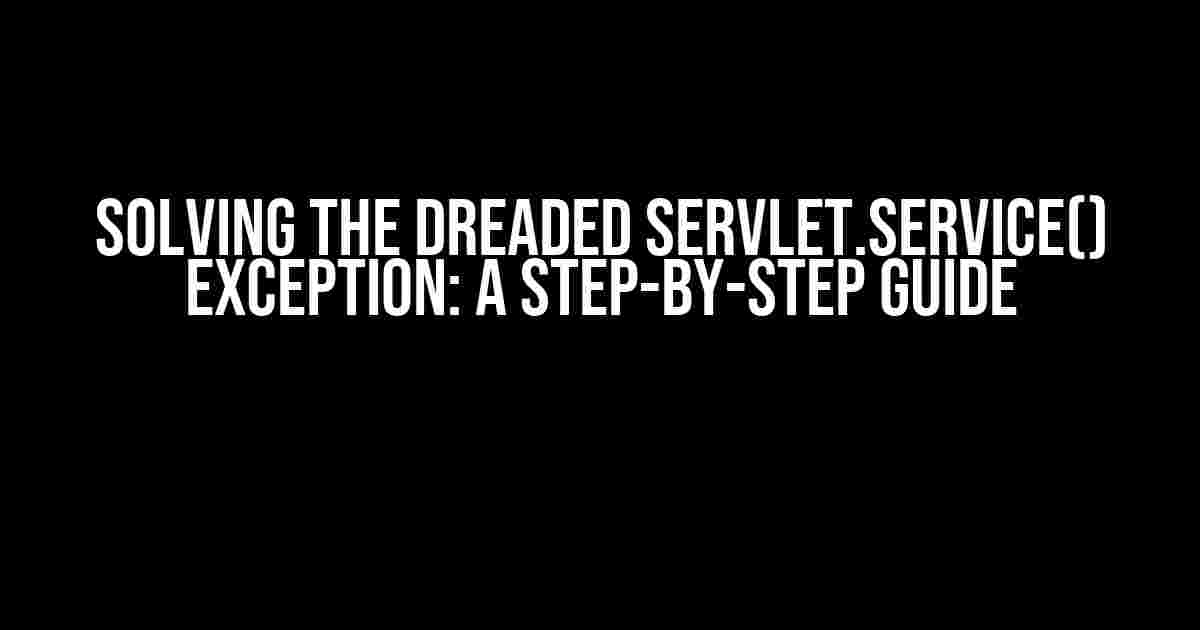Are you tired of banging your head against the wall trying to resolve the infamous Servlet.service() for servlet [helloWorld] in context with path [/MVC] threw exception [Handler dispatch failed: java.lang.NoClassDefFoundError: io/mi error? Well, put down that aspirin bottle and take a deep breath because we’re about to dive deep into the solution.
What is the Servlet.service() Exception?
The Servlet.service() exception is a runtime error that occurs when the Java Servlet container (e.g., Tomcat, Jetty) fails to dispatch a request to a servlet. This error is often accompanied by a cryptic message like the one mentioned above, leaving you wondering what on earth is going on.
The Culprit: NoClassDefFoundError
In our specific case, the error message mentions a NoClassDefFoundError, which indicates that the Java Virtual Machine (JVM) is unable to find a particular class at runtime. This is usually due to a missing or mismatched dependency, misconfigured classpath, or incorrect project setup.
Step-by-Step Troubleshooting Guide
Don’t worry; we’ll break down the troubleshooting process into manageable chunks. Follow these steps to resolve the Servlet.service() exception:
Step 1: Check Your Project Structure
Verify that your project structure is correct. Ensure that your servlet class is located in the correct package and that your web.xml file is properly configured.
Project Structure: MVC |-src |-main |-java |-com |-example |-HelloWorldServlet.java |-webapp |-WEB-INF |-web.xml
Step 2: Review Your Web.xml Configuration
Double-check your web.xml file for any mistakes or omissions. Ensure that the servlet mapping is correct and the servlet class is properly declared.
<?xml version="1.0" encoding="UTF-8"?>
<web-app version="3.1" xmlns="http://xmlns.jcp.org/xml/ns/javaee"
xmlns:xsi="http://www.w3.org/2001/XMLSchema-instance"
xsi:schemaLocation="http://xmlns.jcp.org/xml/ns/javaee
http://xmlns.jcp.org/xml/ns/javaee/web-app_3_1.xsd">
<servlet>
<servlet-name>HelloWorldServlet</servlet-name>
<servlet-class>com.example.HelloWorldServlet</servlet-class>
</servlet>
<servlet-mapping>
<servlet-name>HelloWorldServlet</servlet-name>
<url-pattern>/hello</url-pattern>
</servlet-mapping>
</web-app>
Step 3: Verify Dependencies and Classpath
Make sure you have all the required dependencies in your project, including any third-party libraries. Check your pom.xml file (if you’re using Maven) or your build.gradle file (if you’re using Gradle) for any missing or incorrect dependencies.
<dependencies>
<dependency>
<groupId>javax.servlet</groupId>
<artifactId>javax.servlet-api</artifactId>
<version>4.0.1</version>
</dependency>
</dependencies>
In Eclipse, right-click your project > Properties > Java Build Path > Add Library > Server Runtime > Select your server (e.g., Apache Tomcat v9.0) > Finish
Step 4: Clean and Rebuild Your Project
Sometimes, a simple clean and rebuild can resolve the issue. This step ensures that any changes to your project structure or configuration are reflected in the compiled code.
In Eclipse, Project > Clean > Clean and Build Project
Step 5: Check for Conflicting Libraries
Inspect your project for any conflicting libraries or duplicate jars. Remove any unnecessary or redundant libraries to ensure a clean classpath.
| Library | Version |
|---|---|
| javax.servlet-api | 4.0.1 |
| tomcat-servlet-api | 9.0.37 |
Step 6: Review Your Servlet Code
Lastly, review your servlet code to ensure it’s correct and doesn’t contain any syntax errors. Check for any missing imports, incorrect method signatures, or misplaced annotations.
package com.example;
import java.io.IOException;
import javax.servlet.ServletException;
import javax.servlet.annotation.WebServlet;
import javax.servlet.http.HttpServlet;
import javax.servlet.http.HttpServletRequest;
import javax.servlet.http.HttpServletResponse;
@WebServlet("/hello")
public class HelloWorldServlet extends HttpServlet {
private static final long serialVersionUID = 1L;
@Override
protected void doGet(HttpServletRequest req, HttpServletResponse resp) throws ServletException, IOException {
resp.setContentType("text/plain");
resp.getWriter().println("Hello, World!");
}
}
Conclusion
By following these steps, you should be able to resolve the Servlet.service() for servlet [helloWorld] in context with path [/MVC] threw exception [Handler dispatch failed: java.lang.NoClassDefFoundError: io/mi error. Remember to stay calm, methodically troubleshoot, and carefully review your project configuration, dependencies, and code. Happy coding!
Common mistakes and pitfalls:
- Misconfigured web.xml file
- Missing or incorrect dependencies
- Incorrect project structure
- Conflicting libraries or duplicate jars
- Syntax errors in servlet code
Troubleshooting checklist:
- Review project structure and web.xml configuration
- Verify dependencies and classpath
- Clean and rebuild the project
- Check for conflicting libraries or duplicate jars
- Review servlet code for syntax errors
Remember, the key to resolving this error is to be patient, methodical, and thorough in your troubleshooting approach. Good luck!
Here are 5 Questions and Answers about “Servlet.service() for servlet [helloWorld] in context with path [/MVC] threw exception [Handler dispatch failed: java.lang.NoClassDefFoundError: io/mi”:
Frequently Asked Questions
Get answers to the most frequently asked questions about the error “Servlet.service() for servlet [helloWorld] in context with path [/MVC] threw exception [Handler dispatch failed: java.lang.NoClassDefFoundError: io/mi”.
What does the error “Servlet.service() for servlet [helloWorld] in context with path [/MVC] threw exception [Handler dispatch failed: java.lang.NoClassDefFoundError: io/mi” mean?
This error occurs when the servlet container (e.g. Tomcat) is unable to find a class that is required by the servlet. In this case, the class is likely from the io.mi package, which is not available in the classpath.
What is the cause of this error?
The cause of this error is likely due to a missing dependency in the project or a misconfigured classpath. It could also be due to a typo in the import statement or a mismatch between the package names.
How do I fix this error?
To fix this error, you need to ensure that the required class is available in the classpath. You can do this by adding the missing dependency to your project’s pom.xml file (if you’re using Maven) or by adding the required JAR file to your project’s lib directory.
Can I ignore this error?
No, you should not ignore this error. It indicates that there is a problem with your project’s configuration or dependencies, which can lead to unexpected behavior or errors at runtime.
Is this error related to the MVC architecture?
Yes, the error is related to the MVC (Model-View-Controller) architecture, as it involves a servlet (which is typically used in MVC applications). However, the error itself is not specific to MVC and can occur in any Java-based web application.


